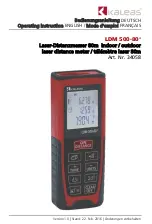
68
c
HAPTER
4:
Computer Interface Operation
F71/F41 Teslameter
*ESR?
Query Format
*ESR?
Remarks
Returns the current contents of the standard event status register. Reading the stan-
dard event status register clears it. The returned value is defined as a <NR1 NUMERIC
RESPONSE DATA> element in the range of 0 – 255. The integer value expressed in base
2 represents the bit values of the standard event status register.
*IDN?
Query Format
*IDN?
Remarks
Returns the unique identification of the device over the system interface. The
response is separated into four fields separated by commas; Manufacturer, Model,
Serial Number, and Firmware level.
*OPC
Command Format
*OPC
Remarks
Causes the device to generate the operation complete message in the standard event
status register when all pending selected device operation have been finished. This
command allows synchronization between a controller and several devices. The OPC
event-bit in the standard event status register (ESR) is used to effect the synchroniza-
tion.
*OPC?
Query Format
*OPC?
Remarks
Places an ASCII character “1” into the device’s output queue when all pending
selected device operations have been finished. This query allows synchronization
between a controller and a device using the MAV bit in the status byte or a read of the
output queue.
NOTE:
Unlike the *OPC command, the *OPC? query does not affect the OPC event-bit
in the ESR.
*RST
Command Format
*RST
Remarks
Performs a device reset.
The Reset command does the following:
1. Except as explicitly excluded below, sets the device-specific functions to a known
state that is independent of the past-use history of the device.
2. Sets the macro defined by *DDT to a device-defined state.
3. Disables macros.
4. Forces the device into the OCIS state.
5. Forces the device into the OQIS state.
The Reset command does not affect the following:
1. The state of the IEEE 488.1 interface.
2. The selected IEEE 488.1 address of the device.
3. The output queue.
4. Any event enable setting, including the standard event status enable register set-
tings.
5. Any event register setting, including the standard event status register settings.
6. The power-on-status-clear flag setting.
7. Macros defined with the define macro contents command.
















































